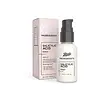What's inside
What's inside
 Key Ingredients
Key Ingredients

 Benefits
Benefits

 Concerns
Concerns

 Ingredients Side-by-side
Ingredients Side-by-side

Water
Skin ConditioningButylene Glycol
HumectantEthoxydiglycol
HumectantSalicylic Acid
MaskingPPG-26-Buteth-26
Skin ConditioningAmmonium Acryloyldimethyltaurate/Vp Copolymer
PEG-40 Hydrogenated Castor Oil
EmulsifyingPhenoxyethanol
PreservativeSodium Hydroxide
BufferingPEG-12 Dimethicone
Skin ConditioningAllantoin
Skin ConditioningChlorphenesin
AntimicrobialDisodium EDTA
Dipotassium Glycyrrhizate
HumectantBisabolol
MaskingAloe Barbadensis Leaf Juice
Skin ConditioningMaltodextrin
AbsorbentGlycerin
HumectantPotassium Sorbate
PreservativeSodium Benzoate
MaskingWater, Butylene Glycol, Ethoxydiglycol, Salicylic Acid, PPG-26-Buteth-26, Ammonium Acryloyldimethyltaurate/Vp Copolymer, PEG-40 Hydrogenated Castor Oil, Phenoxyethanol, Sodium Hydroxide, PEG-12 Dimethicone, Allantoin, Chlorphenesin, Disodium EDTA, Dipotassium Glycyrrhizate, Bisabolol, Aloe Barbadensis Leaf Juice, Maltodextrin, Glycerin, Potassium Sorbate, Sodium Benzoate
Water
Skin ConditioningAlcohol Denat.
AntimicrobialPropanediol
SolventPPG-26-Buteth-26
Skin ConditioningPhenoxyethanol
PreservativePEG-40 Hydrogenated Castor Oil
EmulsifyingMelaleuca Alternifolia Leaf Oil
AntioxidantCaprylyl Glycol
EmollientAmmonium Acryloyldimethyltaurate/Vp Copolymer
Salicylic Acid
MaskingXanthan Gum
EmulsifyingCalophyllum Inophyllum Seed Oil
AntimicrobialDisodium EDTA
Medicago Sativa Extract
TonicPotassium Hydroxide
BufferingAloe Barbadensis Leaf Juice Powder
Skin ConditioningLimonene
PerfumingSodium Hyaluronate
HumectantCitral
PerfumingT-Butyl Alcohol
PerfumingSodium Benzoate
MaskingCitronellol
PerfumingLeptospermum Petersonii Oil
MaskingTocopherol
AntioxidantWater, Alcohol Denat., Propanediol, PPG-26-Buteth-26, Phenoxyethanol, PEG-40 Hydrogenated Castor Oil, Melaleuca Alternifolia Leaf Oil, Caprylyl Glycol, Ammonium Acryloyldimethyltaurate/Vp Copolymer, Salicylic Acid, Xanthan Gum, Calophyllum Inophyllum Seed Oil, Disodium EDTA, Medicago Sativa Extract, Potassium Hydroxide, Aloe Barbadensis Leaf Juice Powder, Limonene, Sodium Hyaluronate, Citral, T-Butyl Alcohol, Sodium Benzoate, Citronellol, Leptospermum Petersonii Oil, Tocopherol
 Reviews
Reviews

Ingredients Explained
These ingredients are found in both products.
Ingredients higher up in an ingredient list are typically present in a larger amount.
Ammonium Acryloyldimethyltaurate/Vp Copolymer (let's call it AAVC for short) is a synthetically created polymer. It's used as a film-forming agent and used to thicken the consistency of products.
AAVC is able to increase the consistency and viscosity of products due to its large molecule size. It also prevents ingredients from separating.
Disodium EDTA plays a role in making products more stable by aiding other preservatives.
It is a chelating agent, meaning it neutralizes metal ions that may be found in a product.
Disodium EDTA is a salt of edetic acid and is found to be safe in cosmetic ingredients.
Learn more about Disodium EDTAPeg-40 Hydrogenated Castor Oil is derived from castor oil and polyethylene glycol (PEG). It is used as a emollient and emulsifier.
As an emulsifier, it helps prevent ingredients from separating. It also helps make the other ingredients more soluble; it is often used to solubilize fragrances. This increases spreadability and elongates shelf life in a product.
Emollients help soothe and soften the skin. They do this by creating a protective film on your skin. This barrier helps trap moisture and keeps your skin hydrated. Emollients may be effective at treating dry or itchy skin.
This ingredient may or may not be vegan, depending on the source.
Peg-40 Hydrogenated Castor Oil may not be fungal-acne safe. We recommend speaking with a professional if you have any questions or concerns.
Learn more about PEG-40 Hydrogenated Castor OilPhenoxyethanol is a preservative that has germicide, antimicrobial, and aromatic properties. Studies show that phenoxyethanol can prevent microbial growth. By itself, it has a scent that is similar to that of a rose.
It's often used in formulations along with Caprylyl Glycol to preserve the shelf life of products.
We don't have a description for PPG-26-Buteth-26 yet.
Salicylic Acid (also known as beta hydroxy acid or BHA) is a well-known ingredient for treating skin that struggles with acne and clogged pores. It exfoliates both the skin's surface and deep within the pores to help clear out buildup, control oil, and reduce inflammation.
Unlike AHAs (alpha hydroxy acids), salicylic acid is oil-soluble. This allows it to penetrate into pores which makes it especially effective for treating blackheads and preventing future breakouts.
Salicylic acid is also known for its soothing properties. It has a similar structure to aspirin and can calm inflamed or irritated skin, making it a good option for acne-prone skin that is also sensitive.
Concentrations of 0.5-2% are recognized by the U.S. FDA as an over-the-counter topical acne product.
It can cause irritation and/or dryness if one's skin already has a compromised moisture barrier, so it's best to focus on repairing that before introducing this ingredient into your routine.
While salicylic acid does not increase sun sensitivity, it’s still important to wear sunscreen daily to protect your skin.
If you are looking for the ingredient called BHA or Butylated Hydroxyanisole, click here.
Learn more about Salicylic AcidSodium Benzoate is a preservative. It's used in both cosmetic and food products to inhibit the growth of mold and bacteria. It is typically produced synthetically.
Both the US FDA and EU Health Committee have approved the use of sodium benzoate. In the US, levels of 0.1% (of the total product) are allowed.
Sodium benzoate works as a preservative by inhibiting the growth of bacteria inside of cells. It prevents the cell from fermenting a type of sugar using an enzyme called phosphofructokinase.
It is the salt of benzoic acid. Foods containing sodium benzoate include soda, salad dressings, condiments, fruit juices, wines, and snack foods.
Studies for using ascorbic acid and sodium benzoate in cosmetics are lacking, especially in skincare routines with multiple steps.
We always recommend speaking with a professional, such as a dermatologist, if you have any concerns.
Learn more about Sodium BenzoateWater. It's the most common cosmetic ingredient of all. You'll usually see it at the top of ingredient lists, meaning that it makes up the largest part of the product.
So why is it so popular? Water most often acts as a solvent - this means that it helps dissolve other ingredients into the formulation.
You'll also recognize water as that liquid we all need to stay alive. If you see this, drink a glass of water. Stay hydrated!
Learn more about Water